Hello, foodie enthusiasts! Today, we’re venturing into the delicious realm of “gogonele” – the Romanian-style pickled green tomatoes. Much like the traditional pickled cabbage, these tomatoes have their own unique charm. What makes them unique? These pickles are crafted without sugar, vinegar, or the hassle of sterilizing countless jars. We’re embracing the simplicity of water, salt, and time. As the saying goes, less is more, and this applies to cooking too. These pickled green tomatoes will introduce a fresh twist to your vegetable palate.
Why Try This Recipe?
- It’s straightforward, fast, and budget-friendly.
- It promises pickles that are unparalleled in taste.
- Like a jigsaw puzzle, a successful pickling endeavor is defined by meticulous planning and the selection of premium ingredients.
Ingredients You’ll Need
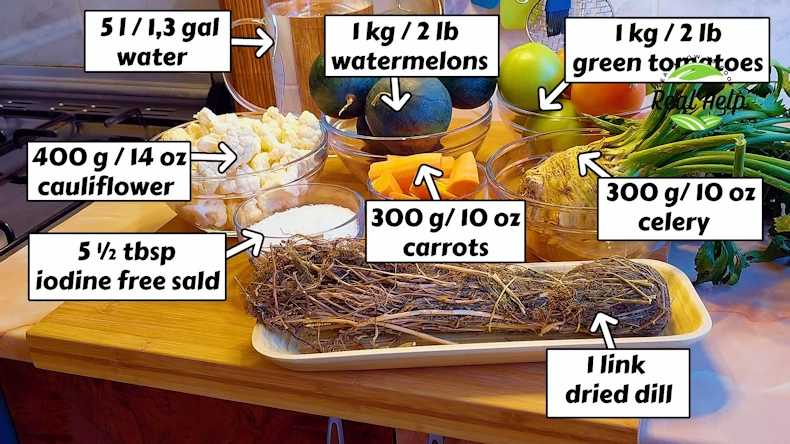

- Green Tomatoes: 1 kilogram or 2 pounds. Some might be completely green, some yellow, and some even orange. The overripe tomatoes will add sweetness next to tanginess.
- Watermelons: 1 kilogram or 2 pounds. Opt for the very small and underripe ones.
- Cauliflower: 400 g or 14 ounces.
- Celery: 1 whole celery with root and leaves, weighing around 300 grams or 10 ounces.
- Carrots: 300 g or 10 ounces.
- Salt: 5 and a half tablespoons. Ensure it’s iodine-free. Table salt is recommended over sea salt.
- Dried Dill: 1 big link.
- Fresh Water: 5 liters.
- Optional: 1 link of basil.
Let’s Get Pickling!
1. Preparing Your Jar


Wash and sterilize your 5-liter or 1.3-gallon jar.
2. Prepping the Vegetables
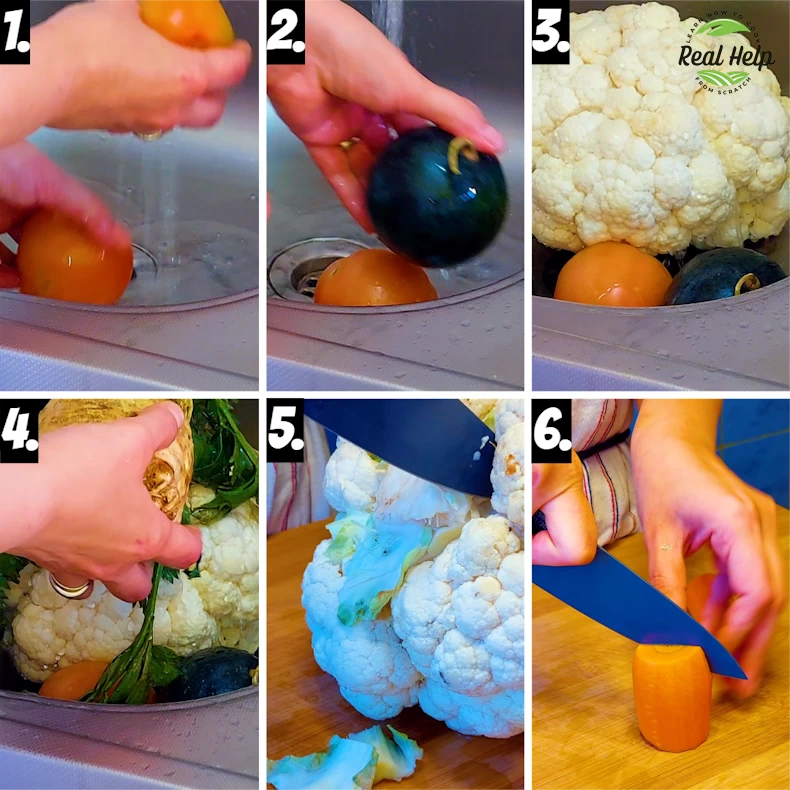

Wash all the vegetables. Portion the cauliflower and carrot. Keep other vegetables intact, but if watermelons are too large, halve them.
3. Making the Brine
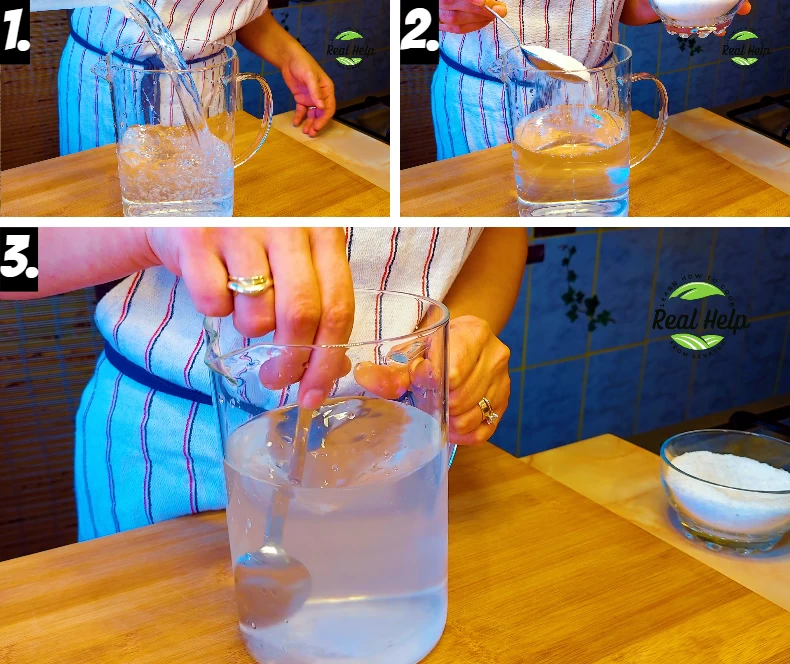

Combine 5 liters of water with 5 and a half tablespoons of salt.
4. Arranging and Brining the Vegetables
Inserting the Veggies


Start by layering the vegetables in the jar, ensuring optimal placement for flavor infusion. Depending on your jar’s design, you might want to place the celery root at the top or bottom for added flavor depth. Remember to also incorporate the dill, ideally in the middle of the jar, to enhance the overall taste.
Pouring the Brine


After arranging the vegetables, pour the freshly prepared brine over them. This step is crucial as it ensures that the vegetables are completely submerged, setting the stage for the perfect pickling process.
5. Storing the Jar


Keep the jar away from light and heat sources.
6. Airing the Pickles
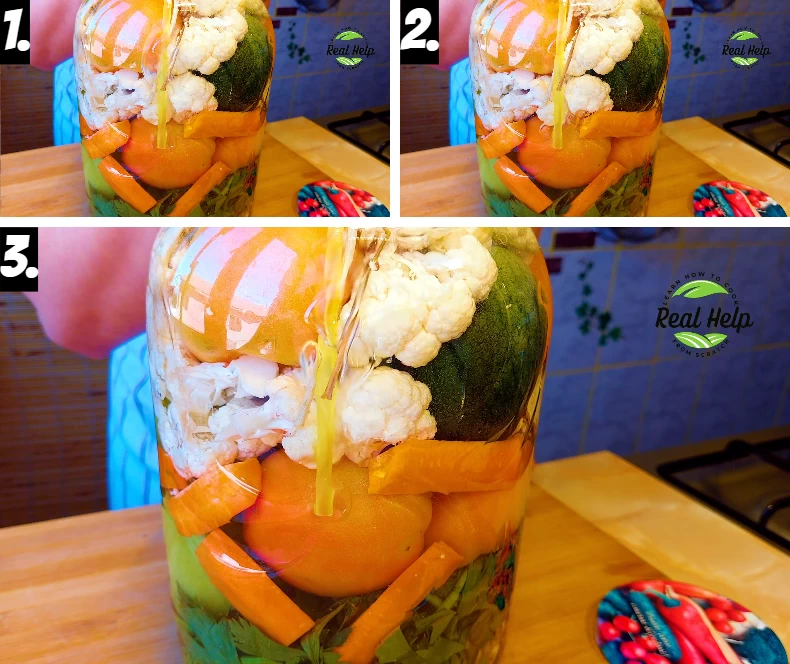

Airing is essential. Start 5-7 days after preserving and continue every 3 days for a few minutes by blowing air into the jar.
7. Monitoring the Pickles
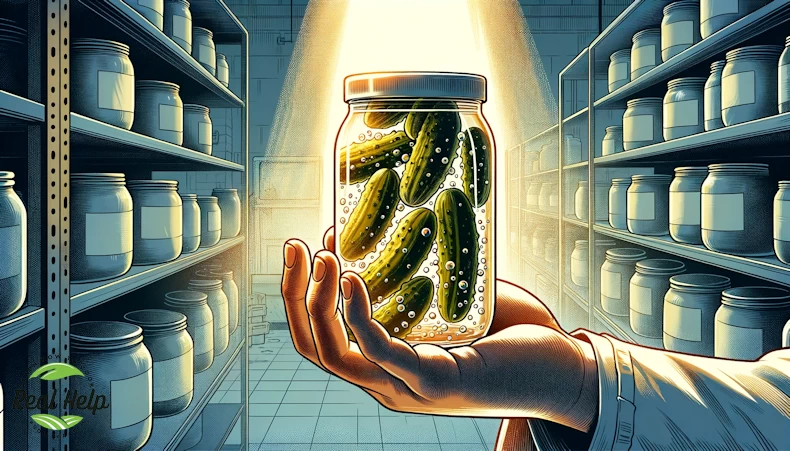

The brine will become cloudy, which is normal. If there’s any growth in the jar, something’s amiss. Store in a dark, cold place with regular airing.
8. Enjoying the Pickles
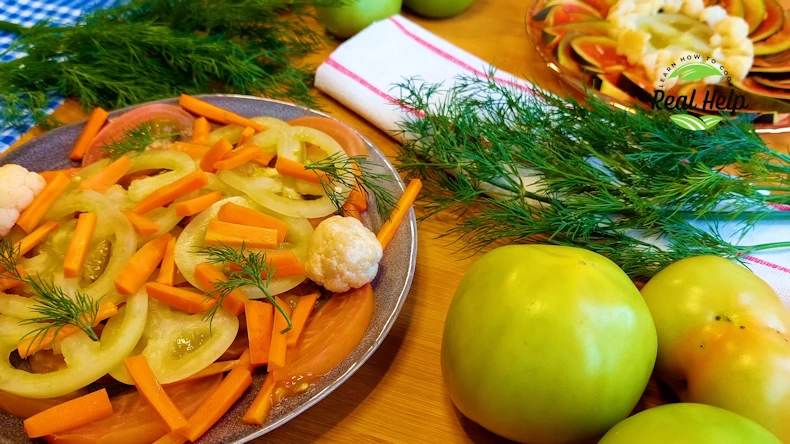

After 3 to 4 weeks, depending on storage conditions, your pickles will be ready to enjoy.
The Airing Process
- Why air? The fermentation process can make the brine cloudy due to the conversion of sugars into lactic acid. Airing helps balance the lactic acid release, ensuring your pickles turn out perfect.
- Airing frequency: Every 3 days for a few minutes.
What dishes pair well with pickled green tomatoes?
Pickled green tomatoes are a versatile condiment that can elevate the flavor profile of various dishes. Their tangy and crunchy texture makes them a delightful addition to many meals. Here are some dishes that pair exceptionally well with pickled green tomatoes:
- Sandwiches: Whether it’s a classic BLT, turkey club, or a veggie sandwich, adding a slice of pickled green tomato can introduce a tangy twist that complements the other ingredients.
- Barbecue: The tanginess of pickled green tomatoes can cut through the richness of barbecued meats, providing a refreshing contrast.
- Grilled Meats: Whether it’s grilled chicken, steak, or fish, a side of pickled green tomatoes can add a burst of flavor.
- Salads: Chop up some pickled green tomatoes and toss them into your favorite salad for an added layer of tanginess.
- Tacos and Burritos: Incorporate pickled green tomatoes into your tacos or burritos for a zesty kick.
- Cheese Boards: The tangy flavor of pickled green tomatoes pairs wonderfully with different cheeses, making them a great addition to cheese boards.
- Fried Foods: Foods like fried chicken, fish and chips, or even fried pickles can benefit from the contrasting tang of pickled green tomatoes.
- Stews and Soups: A few slices of pickled green tomatoes can add a unique flavor dimension to hearty stews and soups.
- Pizzas: Consider adding pickled green tomatoes as a topping on your pizza for a tangy twist.
- Pasta Dishes: Whether it’s spaghetti, lasagna, or a simple pasta salad, pickled green tomatoes can introduce a delightful tangy note.
For a unique culinary experience, try combining pickled green tomatoes with the tasty Romanian mici recipe.
Are pickled green tomatoes healthy?
Pickled green tomatoes, like many pickled foods, come with a set of health benefits and considerations. Here’s a breakdown of their health aspects:
- Rich in Vitamins and Minerals: Green tomatoes are a good source of vitamins A and C, potassium, and iron. These nutrients are retained even after the pickling process.
- Antioxidants: Green tomatoes contain antioxidants, which help combat free radicals in the body, potentially reducing the risk of certain diseases.
- Low in Calories: Pickled green tomatoes are low in calories, making them a guilt-free snack or addition to meals.
- Reduced Waste: Pickling unripe tomatoes can reduce food waste, as it allows you to utilize tomatoes that might not ripen before the end of the season.
- Sodium Content: One consideration when consuming pickled foods is their sodium content. The brine used for pickling often contains salt, which can contribute to one’s daily sodium intake. It’s essential to consume pickled foods in moderation, especially for those monitoring their sodium intake.
- Sugar Content: Some pickling recipes might include sugar or other sweeteners. It’s a good idea to check the ingredients if you’re purchasing pickled green tomatoes or adjust the sugar levels if making them at home.
- Preservatives and Additives: Store-bought pickled green tomatoes might contain preservatives or additives. If you’re concerned about these ingredients, consider making pickled green tomatoes at home, where you can control the ingredients used.
For a balanced meal, consider pairing pickled green tomatoes with a hearty chicken stew.


Can you use any variety of green tomatoes for pickling?
When it comes to pickling green tomatoes, the variety of tomato you choose can influence the final product’s texture and flavor. Here’s what you need to know:
- Firmness: Ideally, you want to select green tomatoes that are firm to the touch. This ensures they retain their crunchiness after the pickling process.
- Size: Smaller green tomatoes, often labeled as “cherry” or “grape” tomatoes, can be pickled whole. Larger varieties might need to be sliced or quartered for even pickling.
- Variety: While most green tomato varieties can be pickled, some are better suited for the process. Varieties like ‘Green Zebra’ or ‘Aunt Ruby’s German Green’ are popular choices for pickling.
- Ripeness: Ensure the tomatoes are genuinely green and unripe. Tomatoes that have started to ripen might become mushy when pickled.
- Flavor Profile: Different tomato varieties have distinct flavor profiles. Some might be tangier, while others are milder. It’s a good idea to taste a tomato before pickling to gauge its natural flavor.
- Heirloom vs. Hybrid: Both heirloom and hybrid green tomatoes can be pickled. Heirloom varieties might offer unique flavors, while hybrids might provide a more consistent texture.
- Skin Thickness: Some green tomatoes have thicker skins, which can affect the pickling process. If you prefer a softer skin, you can blanch and peel the tomatoes before pickling.
- Seed Content: Tomatoes with fewer seeds can result in a clearer brine. However, the seeds typically don’t affect the pickling process or the final product’s taste.
- Availability: Depending on your region and the season, certain green tomato varieties might be more readily available. It’s always a good idea to use fresh, locally-sourced tomatoes for the best results.
- Experimentation: If you’re unsure which variety to use, consider pickling a small batch of different types to determine your preference.
How long do pickled green tomatoes last?
The shelf life of pickled green tomatoes can vary based on the pickling method used and storage conditions. Here’s a guide to understanding their longevity:
- Refrigerator Pickles: If you’re using a quick pickling method and storing the tomatoes in the refrigerator, they typically last up to a month. Ensure the tomatoes are submerged in the brine to prevent spoilage.
- Canned Pickles: If you’re using a traditional canning method, sealed jars of pickled green tomatoes can last up to a year or more when stored in a cool, dark place. Once opened, it’s best to refrigerate and consume them within a month.
- Storage Conditions: Store pickled green tomatoes in a cool, dark place away from direct sunlight. This helps preserve their flavor and texture.
- Seal Integrity: Ensure that the jars are sealed properly. A vacuum seal indicates that the jar is airtight, which is crucial for long-term storage.
- Appearance and Smell: If the pickled green tomatoes develop an off-odor, change in color, or show signs of mold, it’s best to discard them.
- Brine Clarity: If the brine becomes cloudy, it might indicate bacterial growth. While some cloudiness can result from the natural fermentation process, it’s essential to use your judgment and discard any pickles that seem off.
- Salt and Sugar: Both salt and sugar act as preservatives in the pickling process. Adjusting their levels can influence the shelf life of the pickled tomatoes.
- Usage: Always use clean utensils when handling pickled green tomatoes to prevent contamination. Introducing bacteria can reduce their shelf life.
- Pairing with Dishes: If you’re planning to use pickled green tomatoes in dishes, it’s a good idea to remove the quantity you need and store the rest immediately to maintain freshness.
For a delightful combination, consider using pickled green tomatoes as a side dish with how to make chicken livers.
Can you pickle other vegetables using the green tomato pickling recipe?
Absolutely! The pickling brine used for green tomatoes is versatile and can be adapted for various vegetables. Here’s how you can use the same recipe for other veggies:
- Cucumbers: The classic choice for pickling. Ensure they are fresh and crisp. Slice them or pickle them whole.
- Carrots: Slice them into thin rounds or sticks. Their natural sweetness pairs well with the tangy brine.
- Onions: Red or white onions can be thinly sliced and pickled. They’re great for sandwiches and salads.
- Jalapeños: For those who like a kick, pickling jalapeños can add spice to your meals.
- Cauliflower: Break them into small florets. The brine penetrates the cauliflower, giving it a delightful tang.
- Green Beans: Ensure they are fresh and snip off the ends. Pickled green beans are a crunchy treat.
- Bell Peppers: Slice them into rings or strips. Their mild flavor absorbs the brine well.
- Radishes: Slice them thinly. Their peppery flavor becomes milder when pickled.
- Okra: Pickling okra can reduce its sliminess, making it a popular choice for many.
- Mixture: You can also create a mix of various vegetables in one jar, creating a colorful and flavorful medley.
What are the cultural significances of pickled green tomatoes?
Pickled green tomatoes, like many traditional foods, hold cultural significance in various regions. Here’s a look into the cultural aspects associated with them:
- Southern Delight: In the Southern United States, pickled green tomatoes are a staple. They’re often served as a side dish, especially with barbecued or grilled meats.
- Texan Cuisine: In Texas, pickled green tomatoes represent the rich diversity of cultures in the region. They are a symbol of home and traditional meals for many Texans.
- Economic Solution: In many cultures, pickling was an economical solution to preserve excess produce. Green tomatoes, which might not ripen before the season’s end, were pickled to reduce waste.
- Seasonal Transition: Pickling green tomatoes marks the transition from summer to fall. As the tomato plants wind down and the chances of the tomatoes ripening diminish, pickling becomes a way to utilize the remaining harvest.
- Community and Family: The process of pickling often became a communal or family activity. Families would gather to pickle the season’s produce, strengthening bonds and passing down traditions.
- Global Adaptations: While pickled green tomatoes have specific cultural roots, they’ve been embraced by various cuisines worldwide. Chefs and home cooks have adapted and incorporated them into diverse dishes.
- Festivals and Fairs: In some regions, pickled green tomatoes and other pickled foods are celebrated in festivals and fairs, showcasing different pickling techniques and recipes.
- Symbol of Resilience: The act of pickling, preserving food for future use, symbolizes resilience and preparation in many cultures. It’s a testament to the foresight and adaptability of our ancestors.
- Gift-Giving: Jars of pickled green tomatoes are often given as gifts, representing the giver’s effort and the bounty of the harvest.
How can you incorporate pickled green tomatoes into modern dishes?
While pickled green tomatoes have traditional roots, they can be seamlessly incorporated into contemporary dishes. Here are some innovative ways to use them:
- Gourmet Burgers: Elevate your burger by adding a slice of pickled green tomato. Its tanginess can cut through the richness of the meat.
- Pasta Salads: Dice them up and toss them into a pasta salad for a burst of flavor.
- Bruschetta: Use pickled green tomatoes as a base for a tangy bruschetta topping.
- Tacos and Wraps: Add them to tacos or wraps for a crunchy, tangy element.
- Smoothies: For a savory smoothie, blend pickled green tomatoes with other veggies and herbs.
- Gourmet Pizzas: Use them as a topping on artisanal pizzas.
- Grain Bowls: Incorporate pickled green tomatoes into grain bowls with quinoa, rice, or farro.
- Sushi: Experiment by adding them to sushi rolls for a unique twist.
- Tapas and Appetizers: Serve them as part of a tapas spread or as appetizers.
- Dressings and Sauces: Blend pickled green tomatoes into dressings or sauces for a tangy kick.
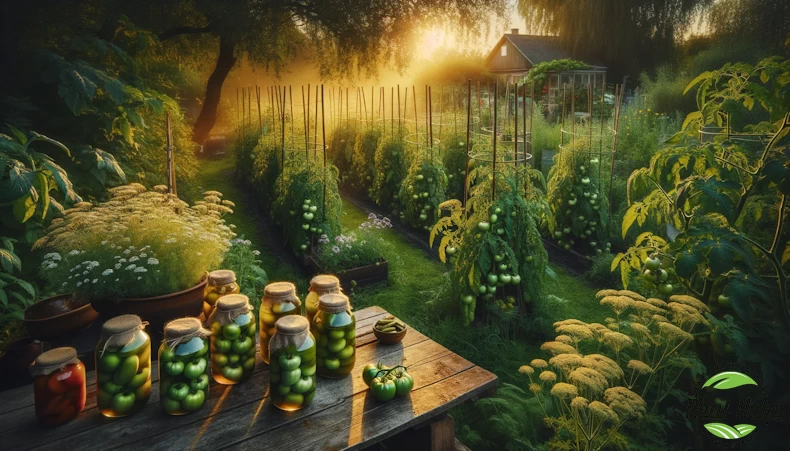

The Final Word
Pickled green tomatoes are not just tasty but also packed with vitamins, antioxidants, and probiotics. They complement various dishes, from BBQs and stews to pot roasts and sandwiches. Whether it’s chicken, beef, or pork, these pickles enhance every meal.
I hope this guide proves useful. If you have any questions or insights, please share them in the comments below. Thank you for reading!
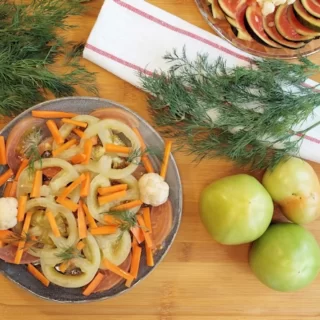

Pickled Green Tomatoes
Dive into the authentic Romanian world of pickled green tomatoes, a delightful blend of tangy, sweet, and salty flavors. This traditional recipe uses fresh green tomatoes, watermelons, and an assortment of vegetables, pickled to perfection without any vinegar or sugar. Enhanced with the aromatic presence of dill and basil, these pickles are a testament to the saying “less is more.” Perfect for those who appreciate the old-fashioned way of pickling with just water, salt, and time. Enjoy a crunchy, flavorful bite that transports you straight to the heart of Romania!
Ingredients
- Green Tomatoes: 1 kilogram or 2 pounds. Some might be completely green, some yellow, and some even orange. The overripe tomatoes will add sweetness next to tanginess.
- Watermelons: 1 kilogram or 2 pounds. Opt for the very small and underripe ones.
- Cauliflower: 400 g or 14 ounces.
- Celery: 1 whole celery with root and leaves, weighing around 300 grams or 10 ounces.
- Carrots: 300 g or 10 ounces.
- Salt: 5 and a half tablespoons. Ensure it’s iodine-free. Table salt is recommended over sea salt.
- Dried Dill: 1 big link.
- Fresh Water: 5 liters.
- Optional: 1 link of basil.
Instructions
1. Preparing Your Jar


2. Prepping the Vegetables


3. Making the Brine


4. Arranging and Brining the Vegetables
Inserting the Veggies


Pouring the Brine


5. Storing the Jar


6. Airing the Pickles


7. Monitoring the Pickles


8. Enjoying the Pickles


Notes
- Choice of Tomatoes: Some tomatoes might be completely green, some yellow, and some even orange. The overripe of the tomato will add sweetness next to tanginess.
- Salt: The salt has to be iodine-free. Using table salt is recommended over sea salt. If the salt contains iodine, the pickles may become mushy and spoil.
- Customization: While celery root and dried dill are essential for balancing the flavor, you can customize other ingredients based on preference. However, for the best taste, it's recommended to follow the exact instructions.
- Water-Salt Ratio: Maintaining the specified water-salt ratio is crucial for achieving pickles with the perfect texture.
- Airing Process: Just like pickled cabbage, pickled green tomatoes also need to be aired. This process starts 5-7 days after preserving and should continue every 3 days for a few minutes.
- Storage: The pickles should be stored in a dark, cold place with regular airing to prevent spoiling.
- Brine Appearance: The brine will become cloudy due to the fermentation process, which is normal. However, if there's any growth in the jar, something went wrong.
- Consumption Time: The pickles will be ready to consume after 3 to 4 weeks, depending on storage conditions.
- Health Benefits: Pickled green tomatoes are a good source of vitamins, antioxidants, and probiotics, contributing to a healthy and tasty diet.
Nutrition Information:
Yield: 20 Serving Size: 150gAmount Per Serving: Calories: 35Total Fat: 0.1gSaturated Fat: 0.03gTrans Fat: 0gUnsaturated Fat: 0.07gCholesterol: 0mgSodium: 1100mgCarbohydrates: 6gFiber: 2gSugar: 3gProtein: 1g
The nutritional information provided is approximate and for reference purposes only. Actual values may vary due to factors such as product brands, preparation methods, and ingredient substitutions. The provided values may not include all nutrients and should not be relied upon as the sole source of nutritional information. Always read product labels and consider individual factors when making dietary choices. We are not responsible for any inaccuracies or adverse effects resulting from the use of this information.


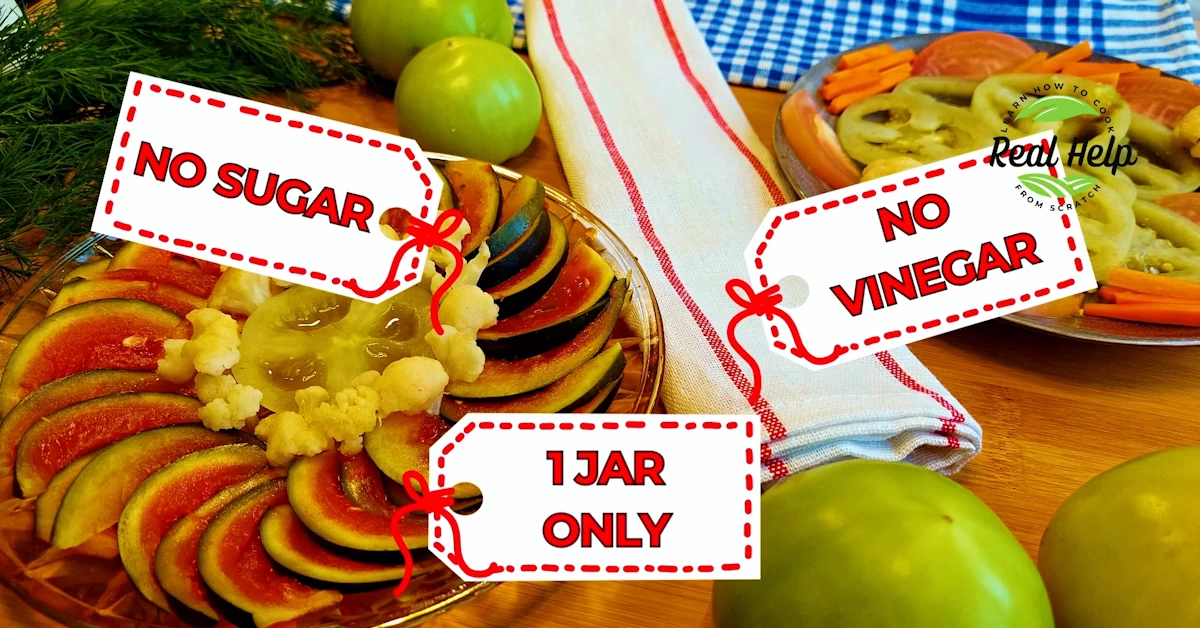

Leave a Reply